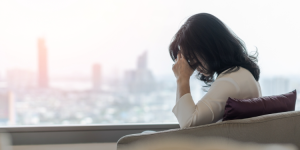
Since November set in, one Pumpkin Spice Latte at a time, many of us in the Northern Hemisphere may have started to feel that familiar autumn crisp that makes us want to dig into a warm blanket and watch the world from behind a large window. But beyond the cozy comforters and heaps of colorful leaves, there is more to autumn when it comes to our emotions. And not all of it is pleasant.
According to data from the World Health Organization, up to 3% of the population worldwide suffers from a condition known as Seasonal Affective Disorder — or SAD. In the United States alone, over 10 million people experience SAD.
What is Seasonal Affective Disorder?
Seasonal Affective Disorder (SAD) is a type of depression that typically happens during the fall and winter months when daylight hours are shorter and there is less natural sunlight. It is sometimes referred to as "winter depression" or "winter blues."
According to Johns Hopkins Medicine and other researchers, there is no one clear cause for SAD. However, there are several factors that directly or indirectly trigger its development:
Reduced Sunlight: SAD is often linked to reduced exposure to natural sunlight, particularly during the fall and winter months when daylight hours are shorter. Having access to less sunlight disrupts your body's internal clock (circadian rhythm) and affects the production of certain neurotransmitters.
Reduced sunlight is, in fact, the main reason behind the popular relocation trend of moving to warmer climates for the winter months.
Ivan and Maria live in Belarus — but they haven't spent a winter at home in the last five years. “A few years ago, we went to Thailand for the winter holidays. We only had two weeks off work, but we were impressed by how much more energetic and productive we felt during this time. Since then, we've made arrangements to be able to travel to a warmer place every winter. Winters in Belarus are not particularly harsh, but there is very little sunlight, and it can snow and rain non-stop for weeks. Getting out of that depressing setting and waking up to a blue sky is really worth the trouble and the expenses for us”.
Biological factors: Changes in the body's biological clock and levels of melatonin and serotonin may play a role in you experiencing SAD. Reduced sunlight can lead to increased melatonin production, contributing to feelings of sleepiness and lethargy.
Genetics: You may also have a genetic predisposition to SAD, as it tends to run in families. Individuals with a family history of depression or SAD may be at a higher risk.
Latitude: SAD is more prevalent in regions located at higher latitudes, where there are more significant variations in daylight hours between seasons. People living farther from the equator are at a higher risk.
Jenny moved to the small town of Tromsø in Norway on a temporary work assignment. And while she loved the nature around her and the environment she was in, she quickly started to feel her energy levels go down. “The toughest time for me is November when the polar night sets in. There is no sunlight at all, and every time of day feels like night. Honestly, if I could sleep through this, I probably would.”
Relocating to a destination that experiences less sign light can, indeed, trigger the onset of SAD. If you are used to a sunny climate, moving to a cloudier region can have a stealthy but profound effect on your well-being. This may even be something you should consider taking into account before making the decision to relocate.
Age and gender: SAD is more common in younger adults and is more frequently diagnosed in women than in men. However, it can affect individuals of all ages and genders.
Preexisting mental health conditions: Individuals with preexisting mental health conditions, such as major depressive disorder, bipolar disorder, or anxiety disorders, may be more susceptible to experiencing SAD symptoms during low sunlight seasons.
It's important to note that while these factors are associated with SAD, the disorder's precise cause can vary from person to person.
Additionally, not everyone living in regions with limited sunlight or experiencing seasonal changes will develop SAD.
Another expat from Norway, Cecilia Blomdahl, has been living in the polar town of Svalbard for several years, documenting her life on her YouTube channel. She shares a very positive experience of the Polar Night and talks about the adaptation strategies that allow her to make the most out of each season.
How to identify SAD as an expat
So, how do you know if you have SAD? One of the key SAD indicators is that the disorder predominantly emerges during the fall and winter months when daylight dwindles. Here are a few indicators that you may be experiencing SAD:
SAD often gives rise to feelings of persistent sadness, hopelessness, and a general sense of despair that can disrupt daily life.
Individuals with SAD frequently experience a profound lack of energy, struggling with even routine tasks and activities.
Sasha moved to Berlin, Germany, from Marbella, Spain, to study. She noted a sharp drop in energy levels and attention span, which she first attributed to the change of scenery and environment. “Later I realized that I had a lot of trouble waking up in the morning, even though I've always been an early riser. I also felt more affected by the weather than I did back home. I started using my vacation time to go back to Spain, and it really helped me get through the year with fewer low-energy episodes”.
The urge to withdraw from social interactions can intensify, leading to isolation and strained relationships.
SAD may trigger significant weight fluctuations, including overeating and weight gain, or conversely, loss of appetite and weight loss.
“When I first moved back home to Warsaw after five years in Southern China, I started eating way more”, — says Katarzyna. “At first, I thought that I just missed Polish food and home cooking. But after a few months went by and my appetite wouldn't settle, I started to realize that I ate way less in China — and I “blame” cloudy Warsaw days for my fuller diet”.
Increased irritability and difficulty managing stress can become more pronounced during SAD episodes.
Excessive daytime sleepiness and an increased need for sleep are common, even after a full night's rest.
Concentration and focus often deteriorate, affecting work and daily responsibilities.
Hobbies and activities that once brought joy may lose their appeal during SAD episodes.
SAD can manifest with physical symptoms such as body aches, headaches, and digestive issues.
Some individuals may experience heightened levels of anxiety, exacerbating overall distress.
It's important to note that the severity and combination of symptoms can vary from one person to another.
What should expats do if changing seasons are impacting their mental health?
As SAD is thought to be strongly related to the lack of sunshine, the most obvious solution to the autumn blues seems obvious — it's travel. And while it may come across as a cop-out, research actually suggests that traveling to sunnier places is an effective remedy for SAD.
This study conducted on a group of individuals with SAD looked into the influence of travel on their well-being and discovered that traveling to warmer climates can indeed have a revitalizing impact. This research introduced an intriguing concept known as "Tourism Therapy," an appealing idea that those suffering from SAD can heal themselves with travel.
Tourism Therapy emphasizes the therapeutic potential of travel to alleviate the symptoms of SAD. It suggests that experiencing new environments, taking in sunlight, and even exploring
different cultures can contribute positively to mental health. This concept aligns with the belief that a change of scenery and climate can serve as a valuable complement to traditional therapeutic approaches.
But what if you can't travel?
If booking a flight and a hotel is not on the cards at the moment, there are several alternatives for you to look into. Here are a few ideas:
Make the most of the sunlight that you have access to: move your desk to the window, wake up an hour early, and spend more time outdoors, especially on sunny days.
Eat well: maintain a balanced and healthy diet to support your overall well-being. Ensure that your meals include a balance of macronutrients, including carbohydrates, proteins, and healthy fats. Omega-3 fatty acids, found in foods like fatty fish (salmon, trout, mackerel), walnuts, flaxseeds, and chia seeds, have been linked to improved mood and reduced symptoms of depression.
Sleep well: stick to a consistent sleep schedule to ensure you get enough rest each night. Wind down before bed with calming activities such as reading, gentle stretching, or taking a warm bath. Avoid stimulating activities like watching intense TV shows or using electronic devices with bright screens.
Explore mindfulness: practice relaxation techniques, such as meditation or deep breathing exercises, to manage stress and anxiety. Guided meditation, deep breathing exercises, and progressive muscle relaxation can all be helpful in helping release SAD symptoms.
Try special SAD lamps: SAD lamps, also known as light boxes and light therapy lamps, have gained significant popularity in recent years as more people recognize the impact of reduced daylight on their mental well-being. These lamps are designed to replicate the effects of sunlight and can vary in intensity to suit individual needs. Typically, it's recommended to use a SAD lamp for about 20-30 minutes within the first hour of waking up, keeping it at an arm's length distance and avoiding direct eye contact with the light.
Summing things up
Whether you are regularly experiencing winter blues or simply feel your comfort level go down when there is less sun, there are proactive steps you can take to not feel this way. If travel is an accessible option, this may be the best way to shake off your winter slump. If it's not, prioritize your mental well-being by spending time outdoors, doing more physical activity, developing healthy eating and sleeping habits, practicing mindfulness, or looking into gadgets like light therapy lamps that can replicate the missing sunlight in the comfort of your own home.



















